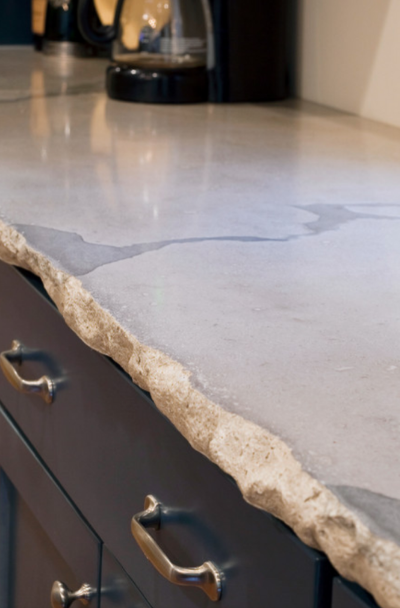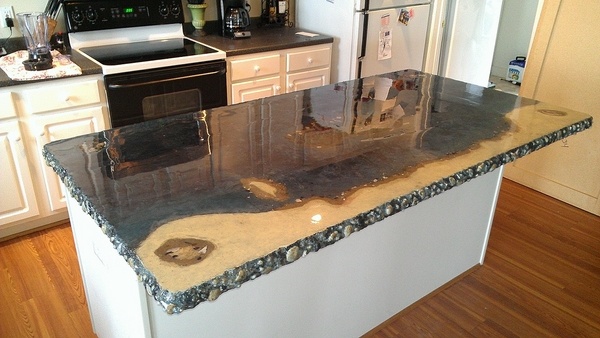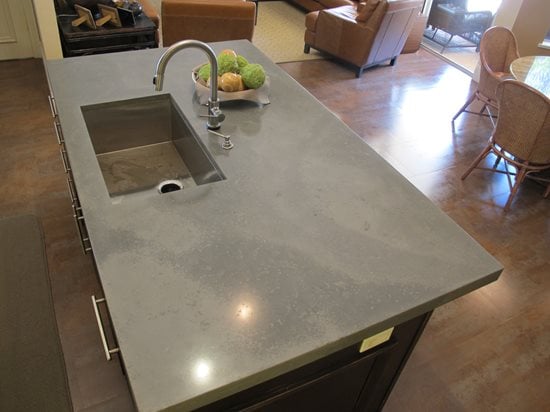When I think of concrete countertops, I imagine a sleek, modern surface that not only serves as a functional workspace but also makes a bold design statement. Concrete countertops have this unique ability to blend into a variety of design styles, from industrial chic to contemporary or even rustic settings. What draws me to concrete countertops is their versatility. Unlike other materials, concrete can be molded into virtually any shape or size, and it can be customized with different colors, textures, and finishes to create a truly personalized look. This makes concrete an excellent choice for homeowners who want something unique and tailored to their space.
One of the most exciting aspects of designing concrete countertops is the range of finishes available. Whether you prefer a smooth, polished surface for a more modern, minimalist look or a textured, matte finish for a rustic vibe, concrete can deliver. I’ve seen concrete countertops with trowel finishes that have a handcrafted, artisanal feel, and others with high-gloss finishes that almost resemble polished stone. The ability to choose different textures and finishes is one of the main reasons why concrete countertops are gaining popularity in both residential and commercial kitchens.
Color is another important factor to consider when designing concrete countertops. One of the things I love about concrete is that it can be colored in a variety of ways, whether through integral pigments mixed into the concrete or by applying stains or dyes to the surface. You can opt for neutral tones like grays and beiges for a subtle, understated look, or go bold with deeper shades like charcoal or even vibrant hues for a more dramatic effect. Concrete’s ability to take on almost any color makes it one of the most customizable countertop options available.
I find it fascinating that concrete countertops can also incorporate other materials into their design, such as glass, stone, or metal. Adding crushed glass or stones into the concrete mix can create a stunning, terrazzo-like appearance while embedding metal accents like brass or copper can give the countertop a luxurious, high-end feel. This ability to mix materials allows for endless creativity and ensures that no two countertops will be exactly alike. I think this is one of the reasons why concrete appeals to people who want a one-of-a-kind piece in their kitchen.

In terms of functionality, concrete countertops are incredibly durable. I appreciate the fact that they’re heat-resistant, which means I don’t have to worry about placing hot pots or pans directly on the surface. This is a big advantage over materials like laminate or even some types of stone, which can be damaged by heat. Concrete is also highly scratch-resistant, especially when it’s properly sealed, making it an excellent choice for a busy kitchen where cutting, chopping, and heavy use are common.
One of the lesser-known advantages of concrete countertops is their sustainability. Many concrete countertops are made using recycled materials, such as fly ash or slag, which are byproducts of industrial processes. This makes concrete a more eco-friendly option compared to materials that require extensive mining or quarrying. I’ve always been drawn to products that have a smaller environmental footprint, and knowing that concrete can be made with sustainable practices is a plus in my book.
However, concrete countertops do require some maintenance, which is something to keep in mind. Since concrete is naturally porous, it needs to be sealed to prevent staining and water damage. In my experience, sealing the countertop every few years is a small price to pay for its durability and beauty. The good news is that once sealed, concrete countertops are relatively low maintenance. A mild soap and water solution is usually all that’s needed to keep the surface clean, and regular sealing helps maintain its stain resistance.

Another interesting design feature of concrete countertops is their ability to incorporate inlays or custom details. I’ve seen countertops that have built-in drainboards, trivets, or even integrated cutting boards. Some designs feature decorative inlays, such as shells, stones, or even coins, which can be embedded into the concrete for a personal touch. These types of custom features make the countertop not only functional but also a conversation piece, which is something I always appreciate in a kitchen design.
One thing to consider when designing a concrete countertop is the edge profile. Concrete can be molded into a variety of shapes, which means the edges can be customized to fit your design aesthetic. Whether you prefer a clean, square edge for a modern look or a more decorative, bullnose edge for a classic style, concrete allows for endless possibilities. I find that the edge detail can make a big difference in the overall look of the countertop and can help tie the design together.
Another advantage of concrete countertops is that they can be made in virtually any size or shape. I love that concrete can be cast in large sections, which means you can have a seamless countertop without any joints or seams. This is especially useful for large kitchen islands or countertops with unusual shapes or dimensions. The flexibility of concrete in terms of size and shape makes it a great option for custom designs where standard-sized materials might not work.
Concrete countertops also offer a unique tactile experience. Unlike colder materials like granite or marble, concrete has a warmer, softer feel, especially when it’s been polished. I’ve found that this makes the countertop more inviting, both to the touch and visually. The smoothness of a polished concrete surface feels luxurious and high-end, yet it maintains a sense of approachability and warmth that I think is perfect for a kitchen space.

In addition to the aesthetic and functional benefits, concrete countertops are also a great investment. While they may have a higher upfront cost compared to materials like laminate or tile, their durability and longevity make them a worthwhile investment in the long run. I’ve seen concrete countertops last for decades with proper care, and because they’re so customizable, they can add significant value to a home. The fact that concrete can be refinished or resealed over time means it can continue to look beautiful for years to come.
For those who prefer a more natural, industrial look, I find that concrete countertops can be left in their raw, unfinished state. This creates a rugged, organic appearance that is perfect for loft-style kitchens or spaces with a more earthy, minimalist vibe. While this look may not be for everyone, I think it adds a level of authenticity and character to a kitchen that’s hard to achieve with other materials. The imperfections in the concrete, such as small air pockets or color variations, become part of the design, giving the countertop a sense of uniqueness and individuality.
I also love that concrete countertops can be paired with a variety of cabinetry and hardware finishes. Whether you prefer the look of sleek, modern cabinets with brushed stainless steel hardware or rustic, reclaimed wood with matte black fixtures, concrete complements both ends of the spectrum. Its neutral tone and ability to take on different colors and textures make it a versatile choice that can adapt to different styles over time.
In terms of installation, concrete countertops are typically custom-made, which means they require professional installation. I’ve found that the process can take a bit longer than with pre-fabricated countertops, but the result is worth the wait. The countertop is usually poured on-site or in a workshop, and because it’s made to fit the exact dimensions of the kitchen, it offers a perfect fit. While the installation process may be more involved, the ability to create a completely custom piece is one of the reasons I think concrete is such a popular choice.

Common Mistakes to Avoid
One common mistake I’ve seen people make with concrete countertops is not properly sealing them. Concrete is porous, so without a good sealant, it can easily stain or absorb moisture, leading to long-term damage. I always recommend sealing the countertop during installation and reapplying the sealant every few years to maintain its durability and appearance.
Another mistake is not considering the weight of concrete countertops. They are quite heavy, especially if you opt for thicker designs, so it’s important to ensure that your cabinets and supports are strong enough to handle the load. Skimping on structural support can lead to sagging or cracking over time.
Last, I’ve noticed that some people choose a design without thinking about the practical implications. For instance, overly textured surfaces can be harder to clean, and bold colors might not age well with changing design trends. It’s important to balance style with functionality to ensure that your countertop serves you well over time.

How durable are concrete countertops?
Concrete countertops are incredibly durable when properly sealed. They are resistant to scratches, heat, and everyday wear and tear. However, because concrete is porous, it’s important to apply a high-quality sealant to prevent staining from liquids like wine or oil. With the right care, concrete countertops can last for decades.
Can I customize the color of my concrete countertop?
Yes, one of the major advantages of concrete countertops is their customizability. You can choose from a wide range of colors by adding pigments, stains, or dyes to the mix. Whether you prefer neutral tones or something more vibrant, concrete can be tailored to suit your design preferences.
Are concrete countertops prone to cracking?
While concrete is durable, it can be prone to hairline cracks, especially if not installed properly. These cracks are usually cosmetic and do not affect the structural integrity of the countertop. Proper reinforcement and careful curing can minimize the risk of cracks forming over time.

How do I maintain my concrete countertop?
Maintenance involves cleaning the countertop with mild soap and water and reapplying a sealant every few years to protect it from stains and moisture. Avoid using harsh chemicals or abrasive cleaners, as these can damage the sealant. Regular maintenance will keep your countertop looking its best for years.
Are concrete countertops expensive?
Concrete countertops can be more expensive than materials like laminate or tile, especially if they’re custom-made. The price typically ranges from $70 to $150 per square foot, depending on factors like thickness, finish, and complexity of the design. However, their durability and customizability make them a worthwhile long-term investment.
Can I install concrete countertops myself?
While it’s possible to install concrete countertops as a DIY project, it’s generally recommended to hire a professional. The process involves precise measurements, pouring, and finishing techniques that require expertise to ensure the countertop is both durable and aesthetically pleasing. Professional installation also ensures the countertop is properly supported, reducing the risk of cracks or other issues.

Modern Concrete Countertops – Sebring Design Build

Concrete Countertops – Pros, Cons, DIY & Care
Related articles:
- Concrete Countertop Overlay
- Black Concrete Countertops
- Marble Look Concrete Countertops
- Light Grey Concrete Countertops
- Concrete Countertop Design Ideas
- Light Colored Concrete Countertops
- Epoxy On Concrete Countertop
- Concrete Countertops Designs
- Concrete Countertops That Look Like Wood
- White Concrete Countertops
